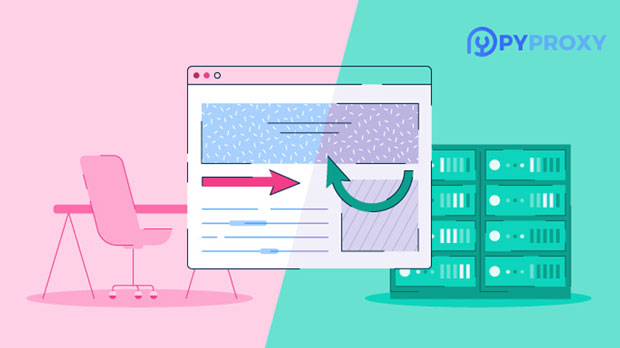When comparing the IP quality and stability of proxy services like PlainProxies and PYPROXY, the key concern is often the reliability of their proxies for business use, security, and performance. Proxy services play a significant role in enabling businesses to access information, manage online operations, and ensure privacy. Both PlainProxies and Pyproxy offer their own sets of advantages, but which one is truly the more reliable option for stable IP quality? In this article, we will compare the two services in terms of their performance, proxy types, pricing models, and customer feedback, offering a detailed analysis that will help you make an informed decision. 1. Introduction: The Importance of Proxy QualityProxies are used to route internet traffic through a third-party server, masking the original IP address of the user. For businesses, the stability and quality of proxies are paramount, especially when dealing with large-scale data collection, security measures, or location-based access. The quality of proxies is determined by several factors, including speed, anonymity, IP rotation, and uptime. Inconsistent or unstable proxies can lead to slower connection speeds, downtime, or even bans from services, making it crucial to choose a reliable proxy provider.2. Understanding PlainProxies and PyproxyBefore delving into a comparative analysis, it's essential to understand the basic offerings of PlainProxies and Pyproxy.PlainProxies provides both residential and datacenter proxies. It claims to offer proxies with high speed and anonymity, targeting businesses that need reliable IPs for web scraping, SEO monitoring, or bypassing geo-restrictions. Its proxies are designed to handle heavy traffic, offering users a balance between affordability and performance.Pyproxy, on the other hand, specializes in rotating residential proxies, offering automatic IP rotation at customizable intervals. This service is ideal for users who need consistent anonymity, especially for tasks such as social media management, automated account creation, or market research.Both services provide access to a large pool of proxies, but their focus on different proxy types and technologies could make a substantial difference in terms of stability and performance.3. Proxy Types: Which One Performs Better?When it comes to stability, the type of proxy plays a pivotal role. The two main types of proxies are residential proxies and datacenter proxies. Understanding how each impacts IP stability is essential.Residential Proxies are considered more stable because they appear as regular user IPs, making them harder to detect and block. These proxies are typically linked to real residential addresses, which makes them less likely to face issues like blacklisting, especially when used for tasks such as scraping or browsing.Datacenter Proxies, on the other hand, are often faster and cheaper but can be detected more easily. These proxies are hosted in data centers and are frequently targeted by websites, which can block them quickly. While they offer higher speed and lower cost, they may not always provide the level of stability required for sensitive tasks.PlainProxies offers both residential and datacenter proxies, while Pyproxy specializes primarily in residential proxies, offering enhanced stability and anonymity for users looking for a more secure and private browsing experience.4. IP Rotation and Anonymity: Impact on StabilityBoth PlainProxies and Pyproxy provide proxy rotation, but the way they handle it differs.PlainProxies offers manual and automatic rotation, allowing users to switch between proxies as needed. The frequency of rotation is typically user-controlled, meaning users can adjust it based on their specific requirements. However, depending on the plan, too frequent rotations can cause temporary instability, particularly if the IP pool is limited or overused.Pyproxy excels in automatic IP rotation, offering continuous rotation at set intervals. This feature is especially useful for long-term tasks like web scraping, where session consistency and IP variation are crucial. By ensuring regular IP switches, Pyproxy minimizes the risk of detection and provides enhanced anonymity, although it might lead to slight delays as the system adjusts the IP.While both services offer IP rotation, Pyproxy's specialized focus on residential proxies with automatic rotation typically results in a higher level of stability, as it avoids the risks of using a limited pool of IPs.5. Performance Metrics: Speed, Uptime, and LatencyPerformance is a critical factor in determining the quality and stability of proxies. To assess this, we need to examine speed, uptime, and latency.PlainProxies provides solid performance with high-speed connections, especially in its datacenter proxies. However, the speed may vary depending on the location and demand on their proxy network. Users report that while PlainProxies offers reasonable uptime and low latency for most regions, it may face occasional slowdowns, particularly when the IP pool is heavily used.Pyproxy, focusing on residential proxies, tends to offer slightly lower speeds compared to datacenter proxies, due to the nature of residential connections. However, its strong emphasis on stability ensures a reliable connection with minimal downtime, making it ideal for users requiring long periods of uninterrupted service. Despite slightly higher latency, Pyproxy’s automatic rotation feature helps minimize delays caused by switching proxies.In terms of uptime, both services maintain good reliability, but PlainProxies may face occasional issues when proxy pools are oversaturated. Pyproxy, by offering rotating residential IPs, generally experiences fewer downtimes but might struggle with speed during peak usage periods.6. Pricing and Value for MoneyPricing is a crucial consideration when choosing a proxy service. PlainProxies offers flexible pricing plans, depending on the number of proxies and the type (residential or datacenter). While datacenter proxies are more affordable, residential proxies come at a higher cost due to their superior anonymity and stability.Pyproxy tends to be priced higher, reflecting the premium service of rotating residential proxies. However, for users who prioritize stability and anonymity, this cost might be justified, especially for businesses that need long-term reliability and consistent IP quality.When it comes to value for money, both services offer competitive rates, but Pyproxy’s focus on residential proxies may offer better long-term stability and privacy, making it a better choice for users who require the highest level of security.7. Customer Support and ReputationBoth PlainProxies and Pyproxy offer customer support, but the level of service and user experience may differ. PlainProxies is known for responsive customer support, with live chat options and helpful troubleshooting guides. However, some users report that response times can be slower during peak periods.Pyproxy provides 24/7 support, including an extensive knowledge base, email support, and live chat. Users often commend the company for its quick responses and customer-centric approach, which can be crucial when dealing with technical issues that may affect proxy stability.Both services have positive reputations in the industry, but Pyproxy is particularly noted for its excellent customer service and its ability to address complex concerns related to proxy stability.8. Conclusion: Which Service Offers the Most Stable IPs?After comparing the key factors of proxy stability, it is clear that Pyproxy tends to offer more reliable and stable IPs due to its emphasis on rotating residential proxies. While PlainProxies offers both residential and datacenter proxies, the limited pool of IPs for datacenter proxies can sometimes result in slower performance and higher chances of being blocked. In contrast, Pyproxy’s automatic IP rotation, combined with its focus on residential IPs, ensures enhanced anonymity and long-term reliability, making it the better choice for users who need stable, uninterrupted service.Ultimately, the decision between PlainProxies and Pyproxy depends on your specific needs. If speed and cost-efficiency are your primary concerns, PlainProxies might be more suitable. However, if stability, anonymity, and long-term reliability are your priorities, Pyproxy is the better option.
Mar 25, 2025
![arrow]()



























































